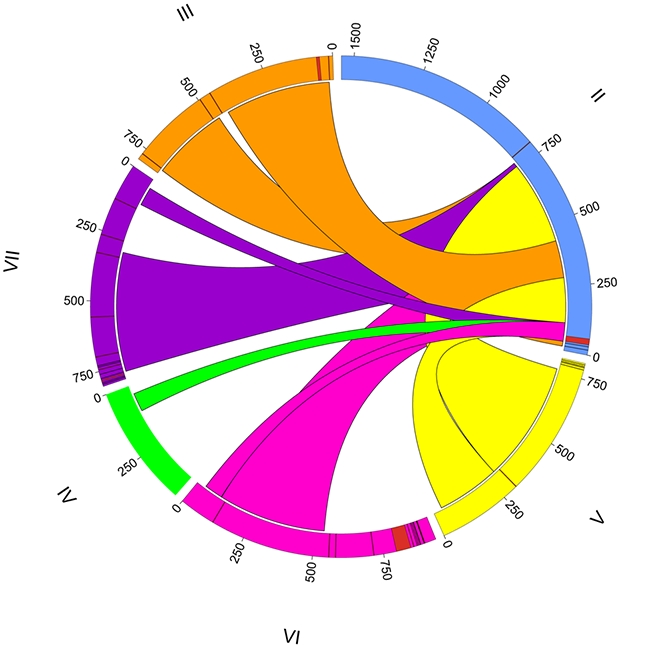
Newsroom
Revealed: Molecular Mechanism of Tetrahymena thermophila Mating Type Determination

The germline nucleus contains a tandem array of six incomplete gene pairs (MTA and MTB), one pair for each mating type. The MTA genes have a common terminal exon (color coded), which is truncated in every gene except mating type II (blue). A complete gene is assembled by joining to the mating type II terminal exon (ribbons). Joining occurs within regions (ribbon width) delineated by polymorphic nucleotides (radial lines). The MTB genes undergo a similar process. Mating type is determined when every incomplete gene pair has been deleted and one complete gene pair remains. (Image Credit: Michael J. Lawson)
Tetrahymena thermophila is an excellent single-celled eukaryotic model organism. A series of groundbreaking achievements have been made in its basic research, such as the Nobel Prize winning discovery of ribozymes,telomere and telomerase.
Unicellular eukaryotes reproduce asexually, but also have a sexual stage to their life cycle that increases genotypic variability. Their sexual partners are usually morphologically indistinguishable and mating types, as part of a self/non-self recognition system, foster outbreeding. The mating type was first discovered by Sonneborn in the ciliate Paramecium aurelia in 1937, and this discovery initiated the field of microbial genetics, as mating types were subsequently found in bacteria and a diversity of microbial eukaryotes.
In 1953, Prof. David L Nanney (University of Illinois) first described the Tetrahymena thermophila mating type, and a total of 7 mating types were found in this organism. Based on this discovery, the genetic manipulation techniques were set up in Tetrahymena thermophila, making it an excellent eukaryotic model organism. During 1954-1960, as the first PhD student of Prof. Nanney, the co-corresponding author of this article, Prof. Eduardo Orias ( University of California, Santa Barbara) started the Tetrahymena mating type study. However, half a century has passed, the problem still remains unsolved.
In 2011, by comparing the transcriptome data in different mating type cells, the Research Group of Protozoan Functional Genomics (PI: Prof. Miao Wei) at Institute of Hydrobiology, Chinese Academy of Sciences (IHB) exactly indentified the mating type determination genes of Tetrahymena thermophila: a pair of head-to-head gene. After deep cooperation between Prof. Miao's lab and Prof. Orias’s lab, they revealed the molecular mechanism of Tetrahymena thermophila mating type determination: all the mating type specific gene sequences existed in the MIC, in the conjugation, only one pair of mating type specific gene sequence leave in the MAC after a series of programed DNA rearrangements.
These results not only revealed the mechanism of ciliates mating type determination mechanism, but also promoted the understanding of sex determination and its origin and evolution, and will greatly facilitate the understanding of cell self / non-self recognition.
The findings were published in the journal PLoS Biology on March 26, 2013. The paper is entitled "Selecting One of Several Mating Types through Gene Segment Joining and Deletion in Tetrahymena thermophila" (http://www.plosbiology.org/).
Link to the Paper: http://www.plosbiology.org/article/info%3Adoi%2F10.1371%2Fjournal.pbio.1001518